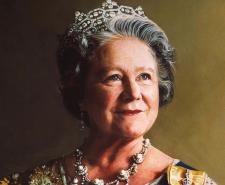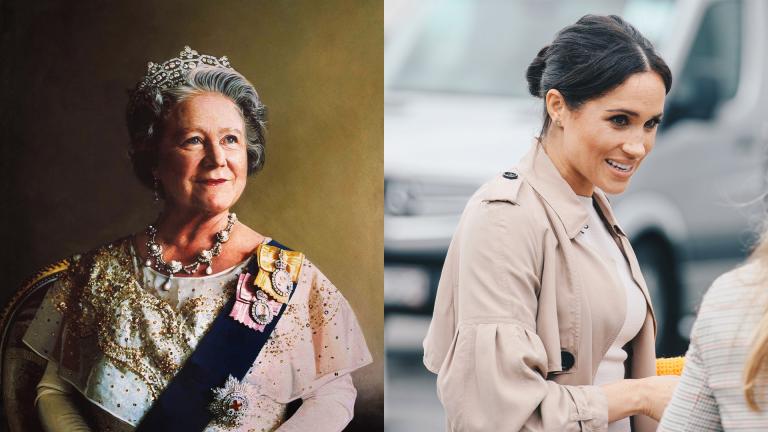
Read more about Kings and Queens

It’s an easy pub-quiz stump: which two royal women share a birthday on the 4th August?
Answer: Elizabeth Bowes-Lyon, later the Queen Mother (born 1900), and Rachel Meghan Markle, Duchess of Sussex (born 1981).
One came of age in a country of ration books and air-raid sirens. The other in a time of smartphones, tabloids and extreme public exposure. Put them side by side and the shared date becomes a neat way to see how the monarchy has changed over the last century, and how public expectations have changed with it.
Just as Sky HISTORY’s Royal Mob peeks behind Queen Victoria’s steely façade, our comparison of two August-born royals invites a similar look beneath the pageantry.
Elizabeth didn’t set out to be queen. She married Prince Albert (the shy second son) in 1923, and they had two daughters, Elizabeth and Margaret. For the most part, she expected a life of duty on the comfortable edges of the royal stage.
13 years later, the abdication of Edward VIII (to wed American socialite and two-time divorcee Wallis Simpson) blew that plan to bits and made her consort to George VI. It was a promotion delivered without ceremony and followed almost immediately by war.
What people remember of her wartime years is not policy but presence. The famous photographs show a small woman in a neat hat picking her way through broken brickwork and chatting to shopkeepers whose premises had been flattened overnight during the Blitz.
Buckingham Palace itself also took bomb damage. Leaving London would have been sensible, but the King and Queen stayed. There were hospital visits, factory tours and calmly delivered radio messages designed to boost national morale.
After the King’s death in 1952 and the ascension of her daughter Elizabeth to the throne, the newly styled Queen Mother found a second act that lasted half a century. She filled it with openings, unveilings, regimental visits, race meetings and the sort of small-scale appearances that make up a public life as a royal. She became something of a national grandmother and could always be spotted on the balcony alongside Queen Elizabeth II with a purse, pearls and an encouraging smile.
Stability and continuity, personified.
Meghan’s route into the family was entirely different. California-born, she worked in television (most notably on Suits) and had been speaking up about women’s rights since she was old enough to write complaint letters. When Meghan married Prince Harry in 2018, the ceremony at Windsor looked, briefly, like a manifesto for a more modern royal household. There was a gospel choir, a love-laced sermon by Bishop Michael Curry and most importantly, a mixed-race American woman walking into a very British institution.
The reality proved far harder. This wasn’t the deferential press of the Queen Mother’s heyday. It was the full modern glare complete with nasty headlines, critical commentary and a noticeable souring of public opinion.
In 2020, she and Harry stepped back from royal duties and moved to North America. Since then, they’ve built a different kind of public life. They’ve founded the Archewell Foundation, experimented with media work and launched projects around mental health and gender equity.
Public perception is never fair and rarely tidy. The Queen Mother’s image, carefully constructed over decades, was of a woman who did the hard yards in hard times and then kept going. Critics existed, but they didn’t get much traction.
Meghan’s image has been baked faster and messier. Every interview is up for debate and every initiative is read for subtext. To many, her arrival represented a long-overdue broadening and modernisation of the royal picture. To others, her departure looked like a rejection of the country by an entitled, outspoken American. The truth is more complicated and much more human.
It isn’t all contrast. Both women discovered that joining the British Royal Family isn’t easy and is for the most part, a learn-as-you-go experience. Elizabeth didn’t ask to be queen and learned on the job during air raids. Meghan didn’t ask to become a constitutional talking point and found herself learning on camera.
Each, in her way, became a screen onto which Britain projected what it wanted from royal women:
Stoic reassurance in Elizabeth’s era.
Authenticity, agency and accountability, in Meghan’s era.
So what does that shared 4th August birthday actually tell us?
The takeaway is simple: royal lives are never entirely their own. Public opinion is always in the room. The Queen Mother leaned on tradition and ceremony to steady her course, while Meghan is navigating a world that demands openness and delivers instant critique.
For more like this, sign up for the Sky HISTORY newsletter. We’ll bring you stories with texture, straight to your inbox.